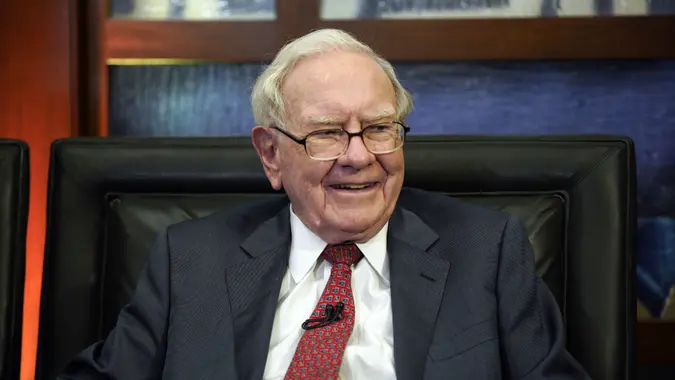Here’s How Much of Your Salary Experts Recommend Investing Every Month

Commitment to Our Readers
GOBankingRates' editorial team is committed to bringing you unbiased reviews and information. We use data-driven methodologies to evaluate financial products and services - our reviews and ratings are not influenced by advertisers. You can read more about our editorial guidelines and our products and services review methodology.

20 Years
Helping You Live Richer

Reviewed
by Experts

Trusted by
Millions of Readers
Trying to figure out how much of your paycheck you should invest each month? A quick internet search might leave you more confused than confident.
The truth is, there’s no one-size-fits-all answer, but financial experts say there are smart guidelines anyone can follow based on their income and long-term goals.
Enough To Get an Employer Match
At bare minimum, if your employer offers a 401(k) plan with matching funds, the most basic rule of thumb is to invest at least up to the point you receive the entire match, according to Rick Miller, a financial planner and investment advisor at Miller Investment Management. While this amount can vary, commonly somewhere between 5% and 8% of your income up to a cap, it is essentially “free” money.
For amounts above that level, you could be better off investing outside the 401(k) or similar plan because of the future required minimum distribution (RMD) rules forcing you to withdraw funds, he pointed out. Your RMD withdrawals are 100% taxable as income.
“Employer plans help because they take a bit out of your check every pay period, so they create discipline for you,” Miller said.
Consider Some Rules of Investing
Whether you have an employer match or not, James Comblo, a certified financial fiduciary and CEO of FSC Wealth Advisors, said that your total savings and investments together should come closer to 20%, following the classic 50/30/20 framework (50% needs, 30% wants, 20% savings/investments).
“Then as you factor in income, age, debt and goals, that number can shift. For higher earners, the goal should be to push well beyond 20%, especially if their lifestyle is under control.”
Comblo also prefers nontraditional budgeting, where instead of paying your bills first and investing what’s left, “you start with your long-term goals, determine how much you will invest first, and build your spending plan around that.”
Consider This Mix of Investments
If you’re just beginning to invest, look to start with ETFs (exchange-traded funds), Miller urged. “The costs will be super low and restrict yourself to index funds for broad exposure.”
This Is a Sign You’re Investing Too Much
While it’s hard to imagine you could over-invest too much of your paycheck, a key sign, Miller said, is “if you find your consumer debt increasing.” Then it may be time to dial back your investing amount to even out your cash flow and minimize interest charges.
If You Started Late
If you started investing late, Comblo said, “Don’t panic, be precise. You may need to invest more aggressively, but you also need to know what you want from your investments and how to maximize the benefits you’re getting.”
Additionally, late starters should focus on using index ETFs and avoiding balanced funds, since any bond components will drag the overall return down, Miller said.
“Be aware that this increases your market risk, so you may want to explore some of the buffered ETFs that provide some downside protection as a diversification.”
Don’t Procrastinate
The worst thing you could do is wait to invest, Comblo said. “Procrastination is the most expensive decision.” He said people often delay investing until things settle down, but we know the market moves higher over 70% of the time so time in the market always beats timing the market.”
The second biggest mistake is underestimating future taxes and not planning for tax-efficient withdrawals later, he said.
Consider These Savings Priorities
Not only is how much you save important, but Comblo recommended a priority order in which to save, that goes as follows:
- Build a one-month emergency fund.
- Pay off high-interest debt.
- Contribute to your 401(k) up to your employer match.
- Build a three-month emergency fund.
- Max out a health savings account (HSA) contribution if available.
- Max out a Roth IRA contribution.
- With any excess savings, invest in permanent life insurance.
- Invest in real estate.
Stay Consistent
No matter your strategy, staying consistent is key to investing, Miller said. “Ideally, if you can keep investing the same amount according to your plan, you will be doing dollar cost averaging, which, over time, is an excellent way to grow into wealth.”
This means that when prices are low, essentially your same contribution buys you more stocks or funds, and less when they are high. This reduces the effects of market volatility and avoiding the chance of investing a lump sum at an inopportune time (like just before a market crash).
If your financial plan is solid, you should not need to make major changes in times of market stress or inflation, Comblo added.
Sources
- Rick Miller, Miller Investment Management
- James Comblo, FSC Wealth Advisors
More From GOBankingRates
 Written by
Written by  Edited by
Edited by 


























